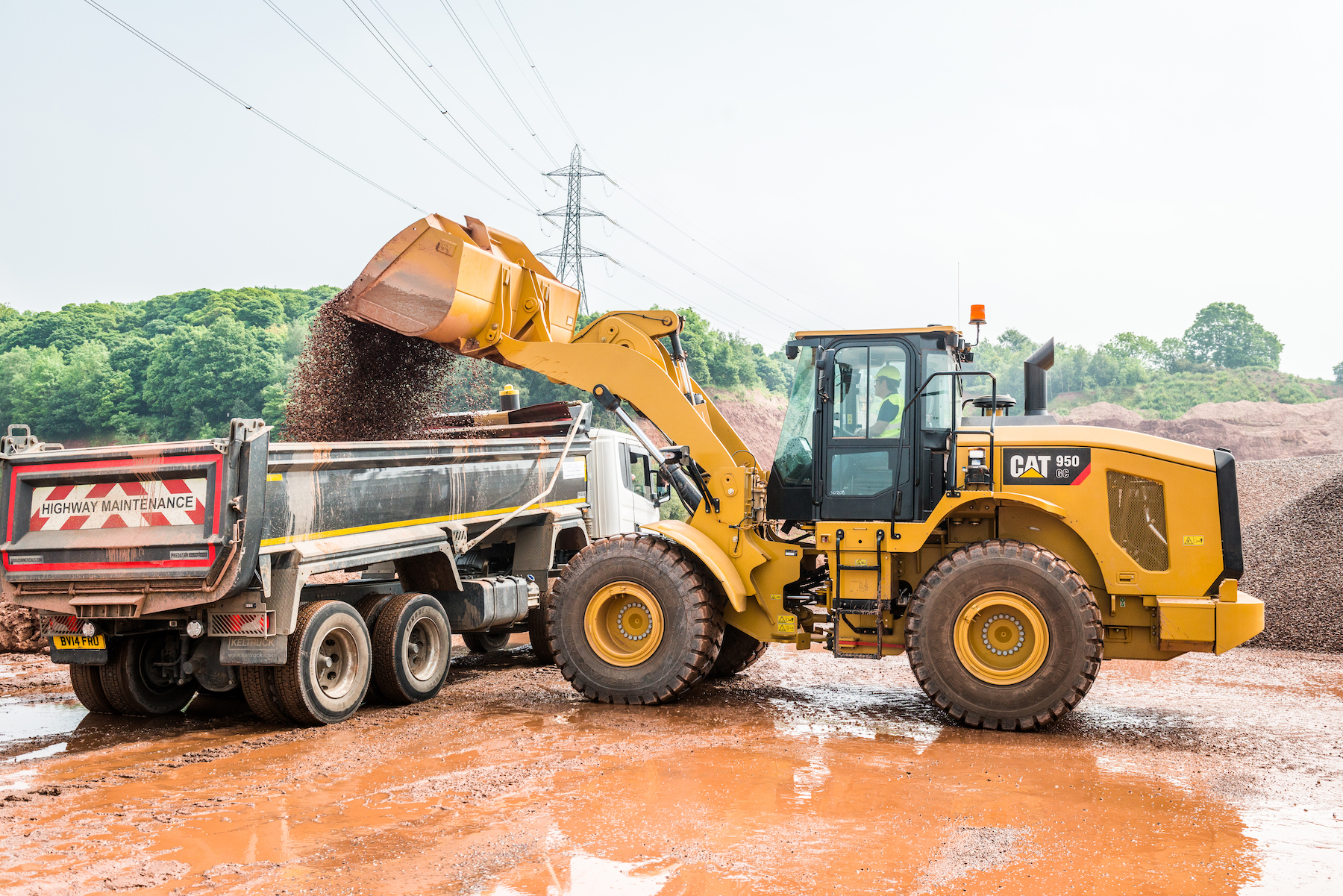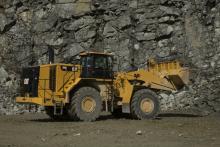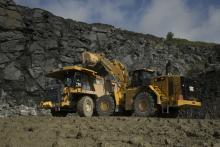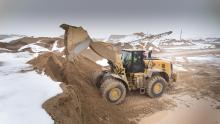
Caterpillar’s medium wheeled loader range continues its impressive evolution, with quarry-suited models for higher and lesser regulated countries, high productivity applications, and more value-driven loading.
Guy Woodford spoke to Thierry Brasseur, Caterpillar’s medium wheeled loaders product & applications specialist about the U.S. giant’s latest mid-sized loader offering.
“These machines offer low fuel consumption and the lowest [loading] cost per tonne,” explains Brasseur. “The 980M 30 tonne and 982M 35 tonne machines in Europe are used to load customer trucks but can also be used as quarry face loading machines. Fitted with the right bucket and L5 tyres, they can do the job!”
On how the M Series wheeled loaders differ from Caterpillar’s predecessor models, Brasseur continues: “We have evolved with the emission regulations, with the M Series wheeled loaders being Stage IV compliant. Our wheeled loaders have the lowest urea consumption in the industry, only 2.5% of the equivalent of diesel. And we also have excellent fuel consumption.
“From H to K to M Series, we have significantly reduced fuel consumption and improved fuel efficiency. The M Series offers 10% more fuel efficiency than the K Series models, and versus the H Series, the improvement is roughly 25%. We have achieved this without any compromise in productivity. This has increased thanks to new additions such as the Cat Performance Series [flat-floor] bucket, which have a wider opening and longer floor. The M Series models also come with a Lock-Up torque converter, which is technology that has evolved since the H and K Series. It improves productivity and fuel efficiency.”
Since the middle of 2016 in lesser regulated countries (LRC), Caterpillar has been replacing H Series medium wheeled loaders with L Series models – with the latest series’ model, the 980, introduced in April 2017.
“The L Series and M Series models are very close from a features and benefits point of view,” notes Brasseur. “Most of the fuel and increased performance benefits, such as the Lock-Up torque converter, over the H Series models will be the same, but we have adapted the L Series to the needs of our LRC customers. They don’t like so much technology and may be struggling to train their operators, so the machines are simpler to use.”
Brasseur says the Stage II or Stage III emission engine-equipped L Series models are also adapted to enable them to work in higher temperatures, such as in the Middle East. “This kind of temperature adaptation is also necessary in some of our M Series models, including those working in some parts of North America like Texas or Arizona, which are very hot weather states.
"One of the differences between the M and L Series is in the traction aids. In North America and Europe the models have a 100% manual or automatic lock differential, as it’s the most efficient system. The manual system requires a lot of operator intervention, so this is not offered as standard on the L Series models.”
Brasseur explains that Caterpillar’s Production Measurement system (CPM) is available for both M Series and L Series Cat wheeled loaders. “This system is a game-changer for optimising the performance of both Series’ models. There are not so many mobile scale devices in use in lesser regulated countries, but we’ve made this system even simpler for LRC use. We’ve seen quite a lot of interest in the tests we’re doing around the system fitted on L Series models for a customer in South Africa. We believe CPM will be very popular in LRC countries.
“We had another mobile scale system for years, but it was not really integrated with the machine. The CPM system is fully integrated, extremely accurate and easy to use through a touchscreen. The utilisation of CPM in Europe is exceeding 70% [of all Cat loading machines].”
Cat’s 2017 M XE models – the 966M XE and 972M XE – are for the most demanding and highest productivity quarry applications, providing the “best fuel efficiency on the market,” claims Brasseur. “Like the M Series models, this does not compromise on productivity. The M XE machines offer 15-30% lower fuel consumption than our M Series wheeled loaders, depending on their application. This means an average lower fuel consumption of 20%. The duty cycle and idling time on these machines are reduced compared to the M Series loaders, due to their more demanding, higher productive-focused applications.
“The M XE models will outperform the M Series models in most applications, especially truck loading and short loading carry, due to their continuously variable transmission system. In long load and carry, the M XE will still outperform the M Series but by a reduced amount, around 10%. This is because when you do this kind of load and carry, both machines run in direct drive.
“For the customer, the choice of an M Series or M XE Series model is economical. It’s based on the number of hoppers versus the fuel you save. Today, in Europe we are selling roughly around 40% M XE and 60% M Series. It’s important to stress from a fuel efficiency perspective, the M Series already offers a big fuel saving of 25% compared to the H Series models. If you’re working a set number of hours in a less demanding application, the M Series wheeled loaders are a very good option.”
Brasseur says that Caterpillar tries to provide customers operating any of its M XE wheeled loaders during one shift for around 2,000 hours a year, a return on their investment within two years.
Moving on to the Cat 950 GC wheeled loaders, Brasseur says the range has been introduced following analysis of customer worksite loading machine data. “We introduced the H Series wheeled loaders in 2005 and had access through telematics and VisionLink to how many hours they were operating. We’ve continued analysing our loading models and based on the data found that in the 950 sized loader class, there were a significant number of customers who weren’t using the machine extensively. These customers don’t need the full productivity and full efficiency of an M Series machine. They are working in lighter material handling applications and for a limited number of hours a year, perhaps due to a long winter shutdown due to freezing temperatures. They may also be contractor customers who are paid only by the hours worked. This makes the 950 GC an interesting alternative.”
Cat 950 GC wheeled loaders have sold well in LRC countries, and Brasseur says they are now available for customers in HRC countries.
“The main advantage of the 950 GC is its simplicity of operation. You don’t have to give an operator specific wheeled loader training to be able to utilise and maximise the efficiency of the machine. In some quarries in Europe, especially when you go north, it’s the truck operators who jump on the wheeled loaders and load their trucks. In this kind of operation, these machines offer great benefits. There are also some quarries which only need a loading machine for peak hours or as back-up. Those quarry operators only want 500 to 1200 hours-a-year from that loader. They aren’t looking for the productivity and efficiency gains of a 950M. The 950 GC is well-suited to that kind of use.”
Brasseur highlights that the 950 GC has a longer lifting arm than the 950M series wheeled loader, generating a 19cm higher bucket articulation point. “We did that to make these machines the best on-highway truck loaders you can have in the industry. The 950 GC also has a simpler version of Cat Product Link, compared to the M, M XE and L Series wheeled loaders.”
On all Cat medium wheeled loaders daily maintenance and 500 hours service can be made from the ground, offering easy access and optimum safety.
Brasseur says operator safety has always been a key consideration when designing Cat wheeled loaders, including the latest medium-sized models. “Our loaders have always had excellent in-cab visibility supported by cameras and mirrors. Now, with our medium sized wheeled loaders, we’re moving one step beyond. In Europe this year, following its launch in North America last year, we’re introducing an integrated Rear Object Detection System (RODS) to all our wheeled loaders. It’s a radar-based system which allows for objects and people to be detected, thus preventing potential collisions. The system is fully integrated into the cab. You do not need an additional display.”
The level of warning to the operator via the RODS is different based on the speed and distance of the machine from the object or person. Brasseur explains: “The system has a fixed range of 16 metres behind the machine and there are five levels of warning. If the machine needs to stop immediately, there is a loud noise alarm. If the machine is moving slowly and from a distance closer to 16 metres, there is only a visual alarm, as the operator has time to react.”








